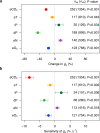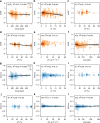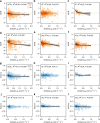Stomatal responses of terrestrial plants to global change
- PMID: 37069185
- PMCID: PMC10110556
- DOI: 10.1038/s41467-023-37934-7
Stomatal responses of terrestrial plants to global change
Abstract
Quantifying the stomatal responses of plants to global change factors is crucial for modeling terrestrial carbon and water cycles. Here we synthesize worldwide experimental data to show that stomatal conductance (gs) decreases with elevated carbon dioxide (CO2), warming, decreased precipitation, and tropospheric ozone pollution, but increases with increased precipitation and nitrogen (N) deposition. These responses vary with treatment magnitude, plant attributes (ambient gs, vegetation biomes, and plant functional types), and climate. All two-factor combinations (except warming + N deposition) significantly reduce gs, and their individual effects are commonly additive but tend to be antagonistic as the effect sizes increased. We further show that rising CO2 and warming would dominate the future change of plant gs across biomes. The results of our meta-analysis provide a foundation for understanding and predicting plant gs across biomes and guiding manipulative experiment designs in a real world where global change factors do not occur in isolation.
© 2023. The Author(s).
Conflict of interest statement
The authors declare no competing interests.
Figures






Similar articles
-
Climate warming alters photosynthetic responses to elevated CO2 in prairie plants.Am J Bot. 2020 Sep;107(9):1238-1252. doi: 10.1002/ajb2.1532. Epub 2020 Sep 15. Am J Bot. 2020. PMID: 32931042
-
Change in terrestrial ecosystem water-use efficiency over the last three decades.Glob Chang Biol. 2015 Jun;21(6):2366-78. doi: 10.1111/gcb.12873. Epub 2015 Mar 20. Glob Chang Biol. 2015. PMID: 25612078
-
Increasing stomatal conductance in response to rising atmospheric CO2.Ann Bot. 2018 May 11;121(6):1137-1149. doi: 10.1093/aob/mcx208. Ann Bot. 2018. PMID: 29394303 Free PMC article.
-
Plant carbon metabolism and climate change: elevated CO2 and temperature impacts on photosynthesis, photorespiration and respiration.New Phytol. 2019 Jan;221(1):32-49. doi: 10.1111/nph.15283. Epub 2018 Jul 8. New Phytol. 2019. PMID: 29983005 Review.
-
FACE facts hold for multiple generations; Evidence from natural CO2 springs.Glob Chang Biol. 2019 Jan;25(1):1-11. doi: 10.1111/gcb.14437. Epub 2018 Nov 13. Glob Chang Biol. 2019. PMID: 30422366 Free PMC article.
Cited by
-
The Identification of Transcriptomic and Phytohormonal Biomarkers for Monitoring Drought and Evaluating the Potential of Acibenzolar-S-Methyl Root Application to Prime Two Apple Rootstock Genotypes for Drought Resistance.Int J Mol Sci. 2025 Jul 21;26(14):6986. doi: 10.3390/ijms26146986. Int J Mol Sci. 2025. PMID: 40725234 Free PMC article.
-
Photosynthetic responses to light levels in drought-tolerant novel peanut (Arachis hypogaea L) genotypes.Sci Rep. 2025 Jul 11;15(1):25032. doi: 10.1038/s41598-025-10978-z. Sci Rep. 2025. PMID: 40646139 Free PMC article.
-
Limited plastic responses in safety traits support greater hydraulic risk under drier conditions.Nat Ecol Evol. 2025 Aug 22. doi: 10.1038/s41559-025-02830-4. Online ahead of print. Nat Ecol Evol. 2025. PMID: 40846760
-
Response of photosynthetic characteristics and yield of grape to different CO2 concentrations in a greenhouse.Front Plant Sci. 2024 Jul 22;15:1378749. doi: 10.3389/fpls.2024.1378749. eCollection 2024. Front Plant Sci. 2024. PMID: 39104849 Free PMC article.
-
Evidence for the acclimation of ecosystem photosynthesis to soil moisture.Nat Commun. 2024 Nov 12;15(1):9795. doi: 10.1038/s41467-024-54156-7. Nat Commun. 2024. PMID: 39532886 Free PMC article.
References
Publication types
MeSH terms
Substances
LinkOut - more resources
Full Text Sources

